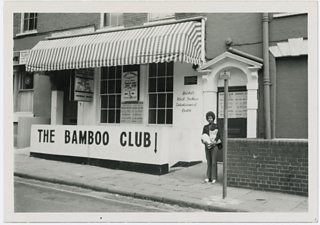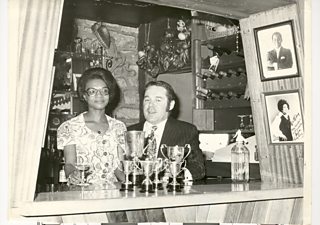The making of 'Beautiful People: The Bamboo Club Story'
Pete Simson
Journalist, Βι¶ΉΤΌΕΔ Radio Bristol
Tagged with:

Tony Bullimore is someone who would occasionally crop-up in the Βι¶ΉΤΌΕΔ Bristol newsroom. His name is synonymous with sailing, exploration, and of course a lucky escape. Every once in a while he would come on-air to comment about sea-faring stories, but it wasn’t until an exhibition came to Bristol in the summer of 2015 that I realised his life before ocean exploration was equally, if not more fascinating.
The exhibition was called “Sound-System Culture,” it documented the rise of the West Indian Sound Systems and the part they played in influencing music in cities across the UK. In Bristol, I learnt that Sound Systems had found a home in the Bamboo Club in the 1970’s, and that the club was run by one Mr Tony Bullimore.
I had heard of the Bamboo Club before. Its name had come up in conversation several times, and for me, like many Bristolians, it had an almost mythical status. I knew it was a small club just-off Portland Square, and I knew it was famous in Reggae circles, but I was about to learn it was much, much more than this.
As a newsroom journalist, I’m able to pitch ideas and cover stories. So, last summer I suggested we do a piece on the “Sound System” exhibition. It was from there I started to do more research on the Bamboo Club.
Instantly two things struck me. One, there was (by modern standards) very little about the club on the internet. Yes there was the odd blog and article mentioning it as former nightspot, with a scattering of photos, but in the main it was a story that remained largely untold. Two, the Club had opened its doors in 1966, therefore there was a 50th anniversary approaching.

The Bamboo Club in Bristol
Having spoken to Tony (a great character) it didn't take long to realise that the influence of the Bamboo Club was so huge, and it was such an important piece of Bristol’s social history, that it needed a proper, in-depth treatment. This is where my colleague Tom Ryan comes into play. Tom is one of the Βι¶ΉΤΌΕΔ’s hidden treasures; his day-to-day role is the station sound producer for Βι¶ΉΤΌΕΔ Radio Bristol. He’s also produced several quite brilliant long-form documentaries which have been broadcast not just here but across Βι¶ΉΤΌΕΔ Radio too. I suggested to Tom that the Bamboo Club would make a great topic for a larger piece of work, and together we worked on a pitch for special funding.
Along the way we learnt that: Bob Marley played his first ever UK gig in Bristol at The Bamboo Club; that Desmond Dekker played there the weekend after becoming the first Reggae artist to reach number one; that Ben E King, Jimmy Cliff, Martha Reeves and many, many, more icons had played there. We met living musical legends such as Toots Hibbert and Derrick Morgan, who both happily agreed to contribute.
We discovered the former Mayor of Bristol, a prominent MP’s Mum, and the famous West Indian Cricket teams of the 60’s and 70’s used to go there regularly. But most importantly, we learnt that the club was the beating heart of the West Indian community. Yes it was a business, but it was also a gathering point for all manner of other clubs, sports teams, societies, charity events, families and friends.

Tony Bullimoreand his wife Lalel
Finally we learnt that Tony and his wife Lalel are revered amongst Bristol West Indians, and they clearly deserve more recognition for the part they have played in the City’s race relations. When the club tragically burnt down in 1977, this beating heart was ripped out of St Pauls with devastating consequences.
What Tom and I hope we’ve finally produced together is a story of racial struggle, of Bristol’s recent past, a story about music, laughter, friendship and family. And we hope as many people as possible hear it, see it, understand and enjoy it.
Pete Simson is a journalist at Βι¶ΉΤΌΕΔ Bristol.
